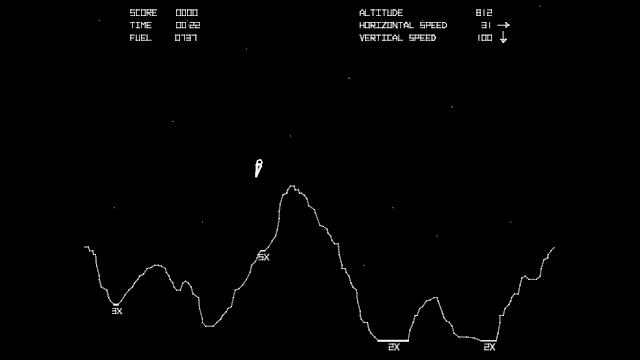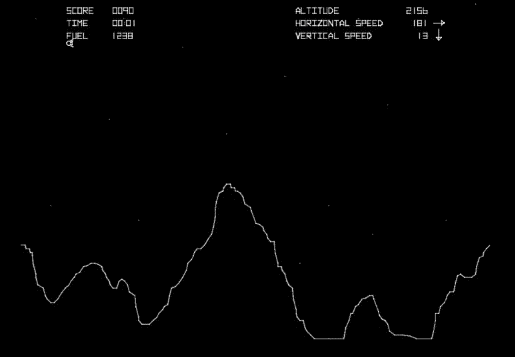Lunar Lander: When Play is an Actual Science
 Even though the moon landing was already a decade old in 1979, the space program still had celebrity status in the American popular consciousness. With Space Invaders already a proven arcade hit, Atari reasonably wondered if a simulation of a real spaceship could generate a similar amount of excitement with arcade-goers.
Even though the moon landing was already a decade old in 1979, the space program still had celebrity status in the American popular consciousness. With Space Invaders already a proven arcade hit, Atari reasonably wondered if a simulation of a real spaceship could generate a similar amount of excitement with arcade-goers. It actually bears a closer resemblance to a homework assignment in a physics class than a video game, and in fact you can solve the problem using undergraduate physics, but presumably the intent is for the "player" to use trial and error. The game has a rather limited shelf life -- an hour or so of tinkering should be enough to converge on a solution that will work and there are no random factors to prevent you using it again. Even so, the game was popular enough to start an entire genre, inspiring several similar games throughout the ‘70s.
By comparison, the arcade version of Lunar Lander, released by Atari in 1979, is much more accessible. It obscures the physics of the landing behind a graphical interface, and focuses more on the piloting process. You can control your orientation throughout the landing, and rather than typing in a fuel burn rate, you push a button on the arcade cabinet to start a burn and then hold it for as long as seems appropriate.
Another improvement is that the game is played in two dimensions, which forces you to account for hills and valleys. It offers bonus points for landing in designated zones, and since you’re not punching in numbers, it’s more difficult to repeat successful landings than it was in the text-only version.
Still, the landing process is slow and there is relatively little variation in the gameplay from one landing to the next. The premise of the game — repeatedly landing a ship in slow motion — feels like a spiritual sacrifice to realism. While there is a certain thrill in navigating a semi-realistic space environment, that wears off quickly and I imagine that any long-term appeal would rely on the gamer actually envisioning themselves as the pilot of a lunar lander. I just didn’t find myself doing that... it was more like playing with a virtual remote control car.
That's not to say that Lunar Lander is an unpleasant experience. I did feel a reasonable amount of satisfaction when I landed safely, but unlike Asteroids or Galaxian, my interaction with the game felt static. Improving my ability to pilot the lander didn't increase my immersion, it just meant fewer crashes. Space nuts might find it interesting to give Lunar Lander a try, especially considering that it is based on real physics (I didn't explore this in detail), but I think most other modern gamers would be justified in passing it by.



Comments
Post a Comment